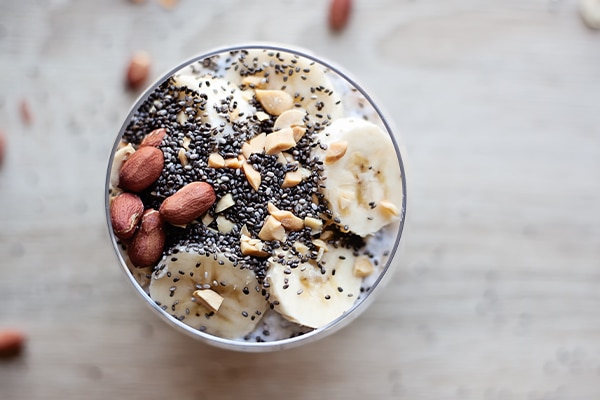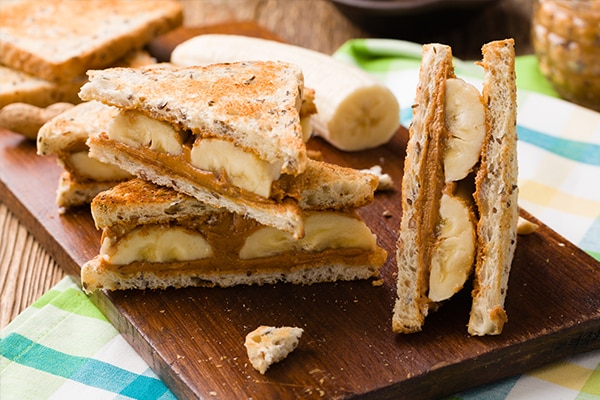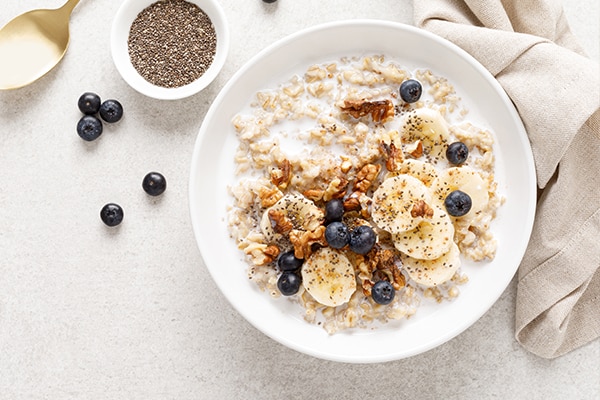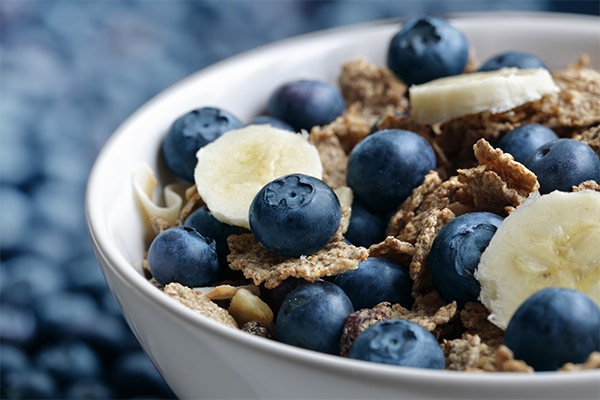The best high fibre foods

Dietary fibre is an important component of a healthy, balanced diet. Fibre is a type of carbohydrate found naturally in plants, including wholegrain cereals, fruit, and vegetables.1
Not only is fibre key for maintaining a healthy digestion system and preventing constipation, but studies have also shown that a high fibre diet is associated with a reduced risk of heart disease, type 2 diabetes and some cancers.2
If you are looking for guidance on how to include more high fibre foods into your diet, you’ve come to the right place. We’ll give you the low-down on fibre rich foods, the difference between soluble and insoluble fibre, and tasty high fibre recipes you can easily incorporate into your day-to-day life.
What is fibre?
Fibre, sometimes referred to as roughage, can be categorised into two broad types – soluble and insoluble.
Both types of fibre are important for overall health, and it's recommended to consume a combination of soluble and insoluble fibre rich foods to reap their respective benefits.
Soluble fibre
Soluble fibre is found in foods such as oats, barley, legumes, fruits (like apples, oranges, and berries), and some vegetables.
This type of fibre dissolves in the fluids in your digestive system to create a gel-like substance, which binds to ‘bad’ cholesterol (low-density lipoprotein, or LDL), bad bacteria, and other unwanted particles in the digestive tract.4
As the soluble fibre moves through the digestive system, it takes these substances along, eliminating them from the body with your stool before they are absorbed into the bloodstream.5
This gel-like viscosity has also been found to help regulate blood sugar levels by slowing down the digestion and absorption of carbohydrates.6
Not only this, but evidence suggests that soluble fibre also acts as a prebiotic, nourishing beneficial bacteria in the gut, which can help contribute to a healthy gut microbiome.7
Insoluble fibre
In contrast, insoluble fibre does not dissolve in water and passes through the digestive system relatively intact.6
This type of fibre is found in foods such as whole grains, nuts, seeds, and the skins of fruits and vegetables and adds bulk and form to your stool, enabling it to pass through your digestive system and out of your body rapidly.8
As this promotes regular bowel movements, research indicated that it may be useful in managing and reducing symptoms associated with common digestive issues like haemorrhoids and diverticular disease.8
How can I increase fibre in my diet?
Our lives can be so hectic that selecting food for their nutrients can become an afterthought.
If you want to include more fibre into your diet and aren’t looking to start taking fibre supplements, we’ve got you covered with some simple tweaks to your existing meal choices.
High fibre breakfast foods
Start your day right with a high fibre breakfast! A high fibre breakfast will keep you full, support healthy digestion, and provide a steady release of energy throughout the morning, setting you up for a productive day ahead.
A brilliant high fibre breakfast option would be whole grain cereals or oats topped with fruits, nuts, and seeds. Add in some berries or sliced bananas for natural sweetness and additional hit of fibre.
Tip: Include fibre rich foods like chia seeds or flaxseeds for an extra boost.

Ditch the: Processed white bread. You may crave toast first thing, but it’s time to step away from the white sliced supermarket loaf, which has only around 1g of fibre per slice (and can be low on nutrients too). This type of bread leaves you feeling unsatisfied and likely to be hungry again by the time you arrive at work.
2 High fibre breakfast ideas
Peanut butter and banana on toast
With this fibre-rich breakfast, you will be well on your way to meeting your 30g daily fibre target, with 7.5g fibre from just one slice:11
- Toast a thick slice of wholemeal bread (3g fibre)
- Top with 1tbsp peanut butter (1.5g fibre).
- Add a small sliced banana (3g fibre).

Fibre-rich oats
Another great breakfast option for a high-fibre day is oats.
- Make a quick pan of porridge on the hob or spin for 3 minutes in the microwave.
- Sprinkle with chia seeds, almonds or fresh or dried fruit for an extra fibre boost.

Incorporating more fibre into your lunch options doesn’t have to be difficult! Here are some tips to up your fibre intake during lunch:
- Choose Whole Grains: Opt for whole grain bread, wraps, or brown rice instead of refined grains. These options provide more fibre and nutrients. Swap white pasta for wholewheat pasta which has an impressive 8g per serving, or you could try chickpea or spelt pasta which are also fibre-rich compared to white.
- Load Up on Veggies: Include a variety of fibre-rich vegetables such as leafy greens, bell peppers, carrots, and broccoli in your salads, stir-fries, or sandwiches.
- Add Legumes: Incorporate legumes like chickpeas, lentils, or black beans into soups, stews, or salads. They are excellent sources of fibre and protein.
- Include Nuts and Seeds: Sprinkle chia seeds, flaxseeds, or almonds onto your salads or incorporate them into dressings for an extra fibre boost.
- Don't Forget Fruit: Pack a piece of fruit like apples, pears, or berries as a refreshing and fibre-filled lunchtime snack.
By incorporating these simple changes, you can enjoy a delicious and fibre rich lunch that supports digestion, keeps you satisfied, and contributes to overall wellbeing.
Fibre rich dinner options
You may find that dinner is the time when you can really get creative with your fibre goals.
Many delicious and healthy grains are high in fibre, such as bulgur wheat, quinoa and wholewheat couscous and pulses e.g., lentils and chickpeas.
Use these as the base for stews, curries and robust salads.
High fibre snacks
Forget salty, fatty snacks like crisps or biscuits.
Make sure you’re smashing your daily 30g fibre target with delicious munch-able snacks such as carrot sticks and hummus with 8g fibre per serving or an apple with almond butter for just under 5g fibre.
A few dried figs, dates, or prunes are great portable fibre powerhouses that taste amazing.
Beware of the high natural sugar content in dried fruit, however. It’s best to measure out a portion beforehand and keep it in a reusable container for when you’re on the go to prevent eating too many.

5 high-fibre foods you won’t hate
These 5 foods are easily available in supermarkets, markets and smaller shops and will add a delicious dose of fibre.12
1
Raspberries
You probably know them as antioxidant powerhouses containing high levels of vitamin C.
But with 8g per serving, raspberries are surprisingly high in fibre.
Raspberries are the perfect snack at any time of day with a handful of almonds (another healthy, fibre-rich food).
2
Popcorn
Plain popped corn is low in calories, fat and high in insoluble fibre with 6g per serving. It might be the perfect snack.
Why not replace crisps with popcorn flavoured with a pinch of salt, or cinnamon for a sweeter taste?
3
Rye bread
If you’ve never tried rye bread, now is the time.
A long-time favourite in Germany and Scandinavian countries, rye bread is gaining in popularity in the UK thanks to its wonderful health benefits.
For a serious fibre boost that will start your day off right, swap your current breakfast for two slices of toasted rye bread with a tablespoon of peanut butter spread on top with a few raspberries.
Or try swapping your usual beans on toast for rye bread. Each slice of rye bread contains around 4.4g of fibre.
4
Hummus
There is plenty to love about this creamy, savoury Middle Eastern dip. Hummus is a source of protein and healthy fats and tastes amazing with vegetable sticks or warm flatbread.
Hummus is also one of the best sources of fibre with 15g per serving thanks to its main ingredient, chickpeas.
When choosing hummus, make sure to stick to the traditional type made with chickpeas, tahini, lemon juice, garlic and salt. Some brands, especially flavoured varieties, add unnecessary sugar and flavourings which offset hummus’ healthy credentials.
5
Chia seeds
If you’ve written chia seeds off as yet another trendy food fad, then you’re missing out!
Chia seeds are tiny seeds with a huge nutritional profile. One of the best vegetarian sources of omega-3 fats, they are high in protein, calcium and iron, and have 11g fibre per serving.
The fibre in chia seeds is mainly the soluble type, meaning it slows digestion, helps you feel full and binds to bad cholesterol.
Extremely versatile, chia seeds can be added to both sweet and savoury dishes. Try them sprinkled on Greek yoghurt, oats or over salad for a mildly nutty flavour.
Vegetables are a brilliant source of fibre that you can easily add to your meals to help you meet your daily goals. Here are some examples of fibre-rich vegetables:12
- Broccoli: Not only rich in vitamins and minerals but also high in fibre, with around 2.6g of fibre per 100g, including both soluble and insoluble fibre.
- Brussels Sprouts: Brussels sprouts are a great source of fibre, with 3.9g of mostly soluble fibre per 100g.
- Carrots: contain both soluble and insoluble fibre, with a slightly higher concentration of insoluble fibre. With around 2.8g fibre per 100g, carrots are extremely versatile - enjoy raw with humous, steamed or roasted!
- Peas: Green peas provide almost 6g of dietary fibre per 100g serving, including both soluble and insoluble fibre.
- Sweet Potatoes: Sweet potatoes are not only delicious but also contain approximately 4g of fibre in a medium-sized cooked sweet potato. This is a great addition to any meal – try to eat with the skin for maximum goodness!
When it comes to cooking vegetables, fibre content can be affected to some extent.
Soluble fibre tends to retain its structure better during cooking, while some portion of insoluble fibre may break down.13
To preserve the maximum fibre content, opt for cooking methods like steaming or sautéing rather than boiling, as prolonged boiling can cause more fibre loss.
The final say
- Dietary fibre plays a vital role in maintaining a healthy, balanced diet.
- Fibre is essential for a well-functioning digestive system and can help prevent constipation.
- Research also suggests that a high fibre diet is associated with a reduced risk of heart disease, type 2 diabetes, and certain cancers.
- However, despite the recommended daily intake of 30g, many individuals fall short of this target.
- To reach your fibre goals, swap out processed white bread and pasta for wholegrains, and look to include more plant foods such as vegetables, legumes, nuts, and seeds.
